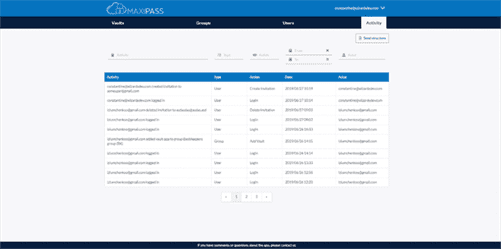The
underscore lets Sass know that the file is only a partial file and that it
should not be generated into a CSS file. CSS on its own can be fun, but stylesheets are getting larger, more complex, and
harder to maintain. Sass has features
that don’t exist in CSS yet like nesting, mixins, inheritance, and other nifty
goodies that help you write robust, maintainable CSS. Still not sure what direction you’d like to go in your development career?

Based on research released earlier this year, the average employee uses 28 different SaaS applications, and in mid-size organizations, seven new applications are introduced each month. This massive pool of data is at the core of the company’s technology, enabling them to provide insights into applications, their usage patterns across hundreds of companies, and actionable remediation. As you’ll learn in a moment, Sass allows for variables and chunks of code that can be reused over and over again. This saves developers a lot of time and reduces the risk of coding mistakes. It also makes it easier and faster to change styles in multiple places in your code, such as frame sizes, border styles, colors, and so on. When business leaders are in the market for a new software as a service solution, it can be tempting to quickly sign up with a provider that looks promising so they can start leveraging the benefits.
‘Which company functions do you automate?’
In future web pages, all you need to do is call out the Mixin rather than remembering to individually call the font, color, and border values. This means when you run Sass code, you’re actually converting your code to CSS. That CSS code output is then used directly by a browser. Think of Sass as a programming “dialect” rather than a whole new language. If you already know CSS, then you’ll be relieved to find that a lot of Sass syntax is identical to CSS.
To create a mixin you use the @mixin directive and give it a name. We’re also using the variable $theme inside the parentheses
so we can pass in a theme of whatever we want. After you create your mixin,
you can then use it as a CSS declaration starting with @include followed by
the name of the mixin.
VariablesVariables permalink
Functions accept inputs from the user and run through specific lines of code to perform complex operations. “We serve hundreds of companies with our Shadow-IT tier, and we studied their SaaS environments and needs.” Galit Lubetzky Sharon, CEO of Wing. And then, finally, there’s the constant updates, upgrades and other maintenance things which make classic software models even costlier and more of a pain. Delivering free updates is painful and tedious and often ineffectual, and upgrades to new versions cost yet more money companies and private users do not want to pay. With our cloud-native AI and analytics platform, you can understand what’s happening with your data now, predict how to pivot seamlessly, and make progress faster. Regardless of role, everyone in your organization will feel the impact of increased performance and productivity.
Neural Notes: How AI improves wine, design and death – SmartCompany
Neural Notes: How AI improves wine, design and death.
Posted: Fri, 06 Oct 2023 01:47:16 GMT [source]
The most direct way to make this happen is in your terminal. Once Sass is
installed, you can compile your Sass to CSS using the sass command. You’ll
need to tell Sass which file to build from, and where to output CSS to. For
example, running sass input.scss output.css from your terminal would take a
single Sass file, input.scss, and compile that file to output.css. To get into the chatbot development, you’ll need to have a good command of these programming languages.
years of analytics innovation
Therefore, a Sass file must first be compiled into CSS before being used in an HTML document. This can be done locally before uploading the CSS to the web server using program like Compass.app or Koala. It can also be compiled on the server using a PHP or Ruby script that compiles Sass into CSS. Sass is the short form of Syntactically Awesome Style Sheet.
- Below, 20 members of Forbes Technology Council share important questions to ask a potential SaaS vendor and what to listen for in their replies.
- For example, if you have multiple styles that are the same color, you need to define the color separately for each style.
- B – You know the levels of permissions given to them and how many employees are using them.
- Instead of retyping changes over and over in CSS, you can simply change the value of your variable of interest in Sass.
- It uses fully-compatible CSS syntax, but provides additional features like CSS variables and nested rules that make CSS more efficient and easier to edit.
Both syntax styles allow you to use variables, Mixins, functions, and other features not available in native CSS. There’s still hot debate on whether CSS counts as a full programming language. But, no https://www.globalcloudteam.com/ matter where you stand on the topic, it’s easy to see that CSS was designed to provide instructions on how a web page should look rather than to perform decision-making tasks and work with variables.
Understand Generative AI: What it is and why it matters.
While everything done in Sass can be done in CSS, Sass helps you, the developer, write code in a way that looks and feels like a programming language. Rather than coding in individual instructions on every page, Sass functions allow you to code in the instructions once. Later on, it’s easy to call your function to perform the same task as many times as you need to. Sass allows you to define variables so you can easily change key values later, such as color, font size, and borders.
Using @extend lets you share a set of CSS properties from one selector to
another. In our example we’re going to create a simple series of messaging for
errors, warnings and successes using another feature which goes hand in hand
with extend, placeholder classes. A placeholder class is a special type of class
that only prints when it is extended, and can help keep your compiled CSS neat
and clean.
Learn how computer vision gives manufacturers another set of eyes.
Sass (Syntactically Awesome Style Sheets) is an extension of CSS. Style sheet languages control where and how text appears on a webpage, from frame size and color to menu positions. But these aren’t the only useful tools for Front-End Developers. sass technology Many people who learn CSS go on to learn Sass for more efficient and consistent web design, especially for large, complex web development projects. Sign up for free and start receiving your daily dose of cybersecurity news, insights and tips.

Sass (short for syntactically awesome style sheets) is a preprocessor scripting language that is interpreted or compiled into Cascading Style Sheets (CSS). Today, mid-sized companies and their CISOs are struggling to handle the growing threat of SaaS security with limited manpower and tight budgets. By focusing on the critical SaaS security needs of these companies, a new approach has emerged that can be launched for $1,500 a year. SaaS is changing the way software and marketing works on a grand scale, so everyone needs to know a little bit about it, even if it doesn’t directly relate to their field. Modernize with your cloud provider of choice for faster, secure access to your data. SAS continues to advance our technologies and bring trusted analytics to companies that impact our everyday lives – so that customers can count on us when it matters most.
SaaS security must-haves: Discover, Asses, Control
While there are a few key differences between the two, most developers who already know CSS can pick up Sass after taking a brief course. At W3Schools you will find complete references of all Sass functions with syntax and examples. Our “Show Sass” tool makes it easy to learn Sass, it shows both the code and the result. Use our color picker to find different RGB, HEX and HSL colors. Sass allows for iterating over variables using @for, @each and @while, which can be used to apply different styles to elements with similar classes or ids.